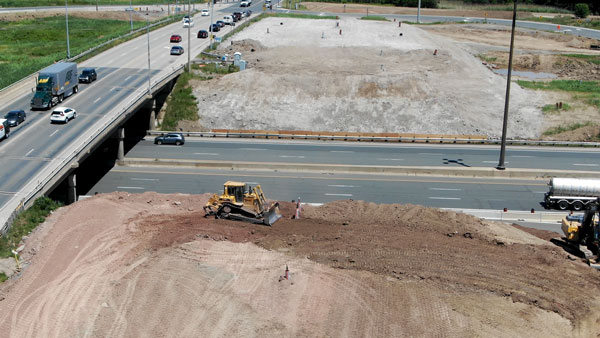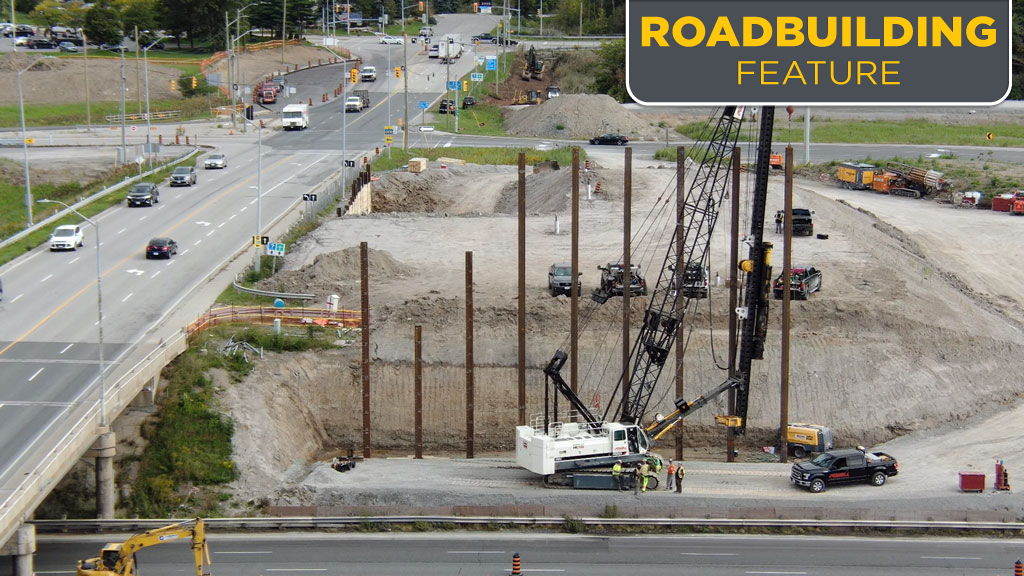The $58-million design build of Ontario’s first diverging diamond interchange has a lot of moving parts and might possibly be the source of some initial confusion for drivers when its opens next fall.
But the project partners, which include the Ministry of Transportation, Niagara Region, and the design/build team of Brennan Paving & Construction Ltd./Morrison Hershfield, believe the new Queen Elizabeth Way/Glendale Avenue intersection in Niagara-on-the Lake will be a vast improvement over the existing interchange,
Glendale Avenue is a north-south street which crosses over the QEW via a bridge which has reached the end of its service life, says Niagara Region’s project manager, Stephanie Huppunen.
But that is not the only issue and problem.
Not only do drivers trying to exit Glendale onto the QEW Toronto-bound ramp have to make left hand turns, but they also often have to wait in line because of the queues at that point. Some drivers hoping to avoid those long line ups will continue further north and then make illegal U-turns.
Traffic congestion in the area is particularly acute, especially as there is a large outlet mall on the west side of Glendale just south of the intersection, while Niagara College’s Niagara-on-the-Lake Campus is on the east side.
“And when the Welland Canal opens, there is even more traffic,” she says, in a reference to the tourist traffic that event generates.
The solution to reducing these “vehicle conflict points” along with allowing unrestricted turning movements, is the new diverging diamond interchange, which is a reconfiguration to allow for direct access to all four directional highway ramps (two off, two one).
A DDI is a type of diamond interchange in which two directions of traffic temporarily cross over onto the opposite side of the road via signalized intersections. As designed at an interchange, the temporary crossover is on a bridge structure over a freeway and the two directions of traffic return to the original side of the road after crossing the bridge.
“Drivers on Glendale Ave will temporarily cross over to the opposite of the road as they pass over the QEW, and then return to the correct side of the road on the other side of the interchange,” she says.
Although this will be the first of its kind in Ontario, diverging diamond interchanges (DDI) have been built in Alberta and Saskatchewan, throughout the United States and other countries globally, says Huppunen.
Originally proposed by AECOM as the consultant conducting an environmental assessment on behalf of MTO and the region, the DDI model was evaluated against a range of other interchange types and assessed in relation to property, cost, environmental impacts, and addressing the traffic/operational needs of the area, she explains.
The next step in the process was an MTO/Niagara Region preliminary design up to the 30 per cent which was completed by WSP Canada. Through the design build, Request for Proposal process, Brennan was awarded the contract to move the design from the 30-per-cent stage to construction.
Asked why the design build delivery method was chosen, she explains it was selected to expedite as the project ties into future projects in the area.
The MTO and Niagara Region are working together in a cost sharing partnership on the project, as there are multiple major items in the staged overall project, all of which will be handled by Brennan.
Right now, though, the centre of activity is the QEW/Glendale Avenue underpass, says Brennan construction manager Andrew Bernard.
Site work for a new 58.70-metre-long by 27.5-metre-wide concrete bridge was completed in January 2021, followed by the installation of the abutments last fall. Construction of the superstructure will commence in the spring, with a scheduled completion sometime this fall.
As the new bridge will only be 10 metres east of the existing one, the construction of new ramps has to be conducted in a sequenced process and there will be some inconvenience to drivers. For example, the QEW Niagara-bound off ramp will be closed for 60 days this summer to permit the erection of a new ramp.
“This closure is unfortunately unavoidable,” says Bernard, noting traffic will be required to detour via the Mountain Road interchange to the east.
Currently Brennan is operating with a reduced work force but will be gearing up in the spring and there will probably be a 40- to 50-member work force on site at the project’s peak this summer, he says.
Also included in Brennan’s scope of work is the construction of a new commuter parking lot on the northwest side of the interchange and the 2023 construction of single-lane roundabout just 400 metres to the north where Glendale meets York Road. It will replace an existing signalized intersection and its purpose is to accommodate high volume turning interactions, stemming, in large part, from a number of hotels along the north side of York Road.












A correction here. Glendale Avenue is not north-south, but east-west. I’m a local and am VERY familiar with it. It’s close to a couple of cycling routes.